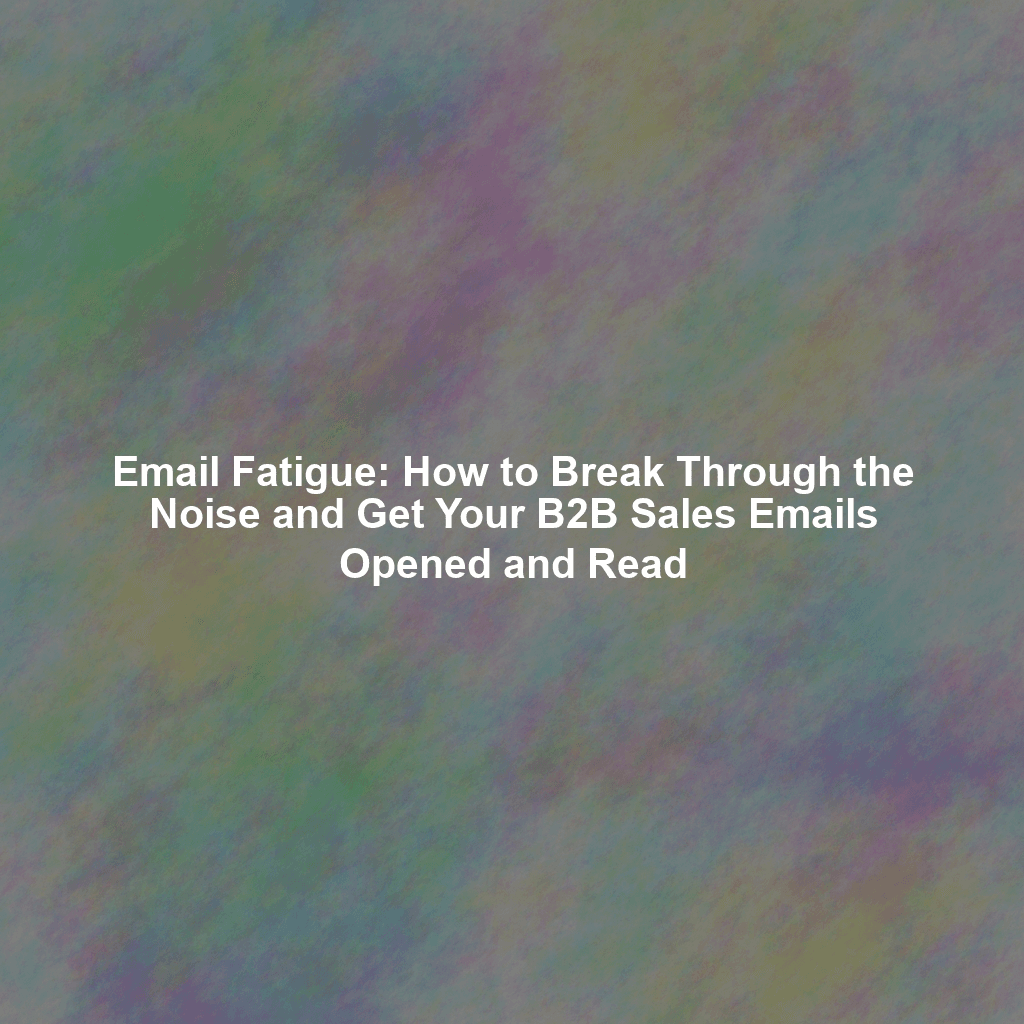In today’s digital landscape, B2B outbound sales efforts are facing a significant challenge: email fatigue. Prospects are bombarded with countless emails every day, making it increasingly difficult for sales emails to stand out, get opened, and drive meaningful engagement. The sheer volume of messages vying for attention has led to a noticeable decrease in the effectiveness of traditional outbound strategies. This article explores the causes of email fatigue and provides actionable strategies to help you cut through the noise, capture your audience’s attention, and revitalize your B2B sales email campaigns.
Understanding the Impact of Email Fatigue on B2B Sales
The flood of emails hitting inboxes daily isn’t just a minor inconvenience; it’s a major obstacle to successful B2B sales. Prospects have become adept at filtering, ignoring, or even outright deleting unsolicited emails, often without even glancing at the sender or subject line. This results in lower open rates, click-through rates, and ultimately, fewer qualified leads and closed deals. The decreasing effectiveness of outbound sales efforts directly impacts revenue generation and requires a strategic shift in how we approach email communication.
The consequences of email fatigue extend beyond just missed opportunities. It can also damage your brand reputation. Consistently sending irrelevant or poorly targeted emails can lead to prospects marking your messages as spam, harming your sender reputation and making it even harder to reach your target audience in the future.
Strategies to Combat Email Fatigue and Improve Engagement
Fortunately, there are several proven strategies you can implement to overcome email fatigue and boost the effectiveness of your B2B sales emails.
Improving Email Deliverability: Reaching the Inbox
Before you can worry about crafting compelling content, you need to ensure your emails are actually reaching the inbox and not getting caught in spam filters. Here are some key steps to improve deliverability:
- Authenticate Your Domain: Implement SPF (Sender Policy Framework), DKIM (DomainKeys Identified Mail), and DMARC (Domain-based Message Authentication, Reporting & Conformance) records to verify your email sender identity and prevent spoofing.
- Maintain a Clean Email List: Regularly clean your email list to remove inactive subscribers, hard bounces, and spam traps. Using a reputable email verification service can help with this.
- Avoid Spam Trigger Words: Steer clear of spam trigger words and phrases that can flag your emails as suspicious. Examples include “free,” “guarantee,” and excessive use of exclamation points.
- Warm Up Your IP Address: If you’re using a new IP address for sending emails, gradually increase your sending volume over time to establish a positive sender reputation.
Crafting Compelling Subject Lines: Grabbing Attention
Your subject line is the first (and sometimes only) chance you have to capture your prospect’s attention. It needs to be intriguing, relevant, and concise. Here are some tips for crafting effective subject lines:
- Personalize the Subject Line: Use the prospect’s name or company name to make the email feel more relevant.
- Ask a Question: Posing a question can pique curiosity and encourage the recipient to open the email.
- Highlight a Benefit: Focus on the value proposition and what the prospect will gain by reading the email.
- Create a Sense of Urgency: Use time-sensitive language to encourage immediate action, but avoid being overly aggressive.
- Keep it Short and Sweet: Aim for a subject line that is around 50 characters or less to ensure it displays properly on mobile devices.
Personalizing Email Content: Making it Relevant
Generic, mass-produced emails are a surefire way to get ignored. Personalization is key to breaking through the noise and making your emails feel relevant and valuable to each individual prospect.
- Segment Your Audience: Divide your email list into smaller segments based on industry, job title, company size, or other relevant criteria.
- Tailor Content to Each Segment: Create email content that addresses the specific needs and pain points of each segment.
- Reference Past Interactions: If you’ve previously interacted with the prospect on social media or at an event, mention it in your email to create a connection.
- Demonstrate Understanding of Their Business: Show that you’ve done your research and understand the prospect’s business goals and challenges.
Optimizing Send Times: Reaching Prospects When They’re Engaged
The timing of your emails can significantly impact open rates and engagement. Experiment with different send times to determine when your target audience is most likely to be receptive to your messages.
- Consider Time Zones: If you’re targeting prospects in different time zones, adjust your send times accordingly.
- Test Different Days of the Week: Experiment with sending emails on different days of the week to see which days generate the highest open rates.
- Analyze Your Data: Use your email marketing platform to track open rates and click-through rates by send time to identify optimal send times for your audience.
Using A/B Testing to Enhance Email Engagement
A/B testing is a powerful tool for optimizing your email campaigns and improving engagement. By testing different elements of your emails, you can identify what resonates best with your audience and refine your approach accordingly.
- Test Different Subject Lines: Experiment with different subject line variations to see which ones generate the highest open rates.
- Test Different Calls to Action: Try different calls to action to see which ones drive the most clicks.
- Test Different Email Layouts: Experiment with different email layouts and designs to see which ones are most visually appealing and engaging.
- Test Different Personalization Techniques: Try different personalization techniques to see which ones resonate best with your audience.
Conclusion: Reclaiming the Inbox and Driving B2B Sales Success
Email fatigue is a real and growing challenge for B2B sales professionals. However, by understanding the causes of email fatigue and implementing the strategies outlined in this article, you can break through the noise, capture your audience’s attention, and revitalize your outbound sales efforts. Focusing on deliverability, crafting compelling subject lines, personalizing your content, optimizing send times, and leveraging A/B testing will allow you to reclaim the inbox and drive meaningful engagement that leads to increased leads, conversions, and ultimately, B2B sales success. Remember, it’s not just about sending more emails; it’s about sending the right emails to the right people at the right time.
 Skip to content
Skip to content

